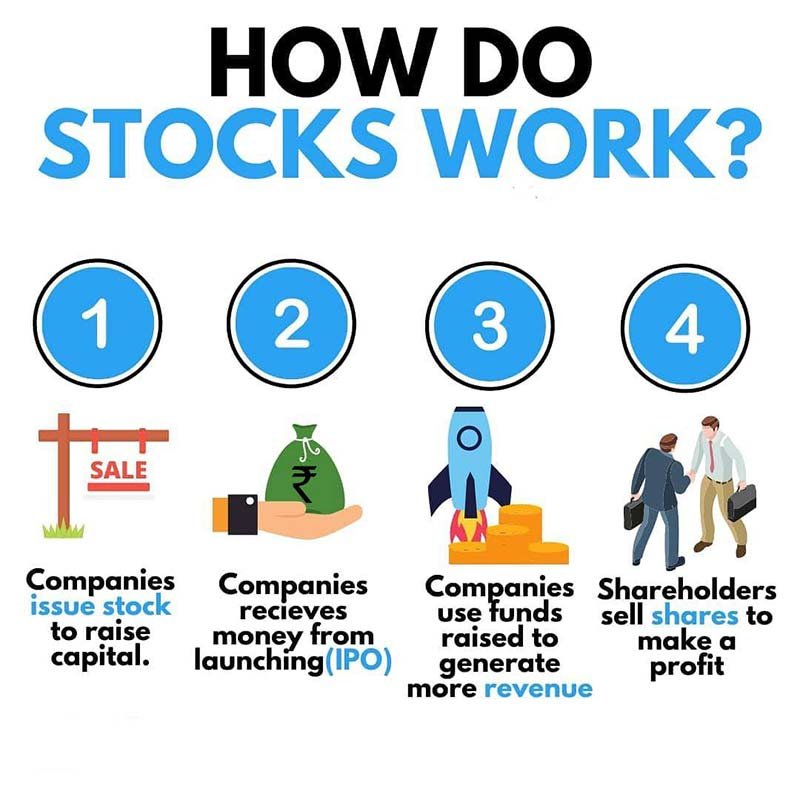Stocks are ownership units in a company, also called shares or equities. They make a claim on the company’s assets and earnings. Stocks play a key role in financial markets, letting companies raise money for growth while giving investors a chance to profit as company succeeds.
By buying stocks, investors partially own the company and their investment value depends on how company performs and overall market conditions. Understanding what stocks are and how they work is essential for anyone looking to build a diverse investment portfolio and improve their financial future.
What exactly are stocks?
Stocks basically mean you own part of a company. When you buy stocks, you become a shareholder. You get a share of that company’s assets and earnings. The value of your stocks goes up and down depending on how well the company performs and what’s happening in the market.
As a shareholder, you can potentially make money two ways: through stock price increases capital appreciation and through dividends (a part of the profits the company pays out to shareholders)
However, stocks carry risks too. Stock prices can drop and profits aren’t guaranteed.
Companies issue stocks to raise money for growing the business, paying off debt or funding new projects. By selling stocks, companies let investors participate in their growth while also getting capital they need to operate and expand. If you want to build a well-rounded investment portfolio that could grow over time, it’s very important that you know what stocks are and how they work.
Stock Classifications

Stocks get put into different categories based on factors like market capitalization and investment style.
Market cap refers to total dollar value of a company’s outstanding shares. It’s used to label stocks as small-cap, mid-cap or large-cap.
- Small-cap stocks have a market cap between $300 million and $2 billion.
- Mid-caps fall between $2 billion and $10 billion.
- Large-caps are over $10 billion.
Another classification method is by investment style – growth versus value stocks. Growth stocks should expand faster than market average, while value stocks trade at lower price compared to their fundamentals.
How do stocks work?

Stocks get bought and sold on stock exchanges which are marketplaces all diverse owing buyers and sellers to trade stocks. Exchanges like New York Stock Exchange (NYSE) and Nasdaq provide a platform for investors to trade.
A stock’s price gets set by supply and demand. When more people want to buy a stock than sell it, the price rises. And when more look to sell than buy, the price drops. Factors like company performance, market conditions, investor sentiment and economic indicators influence supply and demand.
Issuing new stocks is called an initial public offering (IPO) and it takes place in primary market. Once issued, stocks can trade between investors in secondary market – what most call the stock market.
Stock Market Mechanics
The stock market has two main segments- the primary market and secondary market.
- In primary market, companies issue new stocks via IPOs or follow-on offerings to raise capital. This lets companies sell shares directly to investors, with money going to the company.
- Once issued, stocks trade hands in secondary market where investors buy and sell existing stocks. The secondary market is what most think of as the “stock market”. Here supply and demand determine prices and investors can profit from price changes.
Role of Stock Market

The stock market plays vital economic roles.
- First, it lets companies raise money by selling shares to investors. This capital can fund growth, pay off debt or finance new projects. By providing companies access to capital, the stock market supports economic growth and innovation.
- Second, the stock market creates and maintains wealth for investors. As companies become more profitable, their share prices tend to rise. This leads to capital appreciation for shareholders. Some companies also pay shareholders dividends, providing regular income.
- Finally, the stock market indicates the overall economic health. Stock prices reflect investor sentiment, company performance and expectations about the future economy.
What is Capital Appreciation
Capital appreciation means increase in a stock’s value over time. When an investor buys shares and the price rises, the difference between purchase price and higher selling price is the capital appreciation. This is one key way investors profit from stocks.
Stocks can appreciate in value because as a company grows and earns more profit, investors are willing to pay more per share, which increases the stock price. Factors like strong economic growth, better company performance and positive investor sentiment contribute to capital appreciation.
A deep understanding of stocks and the concept of capital appreciation is very important for investors seeking long-term portfolio growth. By investing in stocks with strong prospects, investors can potentially benefit from significant capital appreciation over time.
Dividend Income

Dividend income is another way investors make money from stocks. Some companies share their profits with shareholders by paying dividends. Dividends get paid monthly, quarterly or yearly, depending on the company’s performance and dividend policy.
When a dividend gets declared, shareholders on record date are entitled to payment. Dividends can be paid in cash or extra stock shares (stock dividends). Cash dividends provide regular income to investors, which can be reinvested or used for personal expenses.
Investing in dividend-paying stocks can be attractive for investors seeking steady income, especially in retirement. However, dividend payments aren’t guaranteed and companies can reduce or eliminate them any time. Knowing how dividend income works matters when evaluating stocks and building a portfolio aligned to your financial goals.
How to Invest in Stocks
Investing in stocks involves a few key steps. First, open a brokerage account to buy and sell stocks. Next, determine your investment goals, risk appetite and amount to invest.
You can then choose to invest in individual stocks, mutual funds or exchange-traded funds (ETFs). Individual stocks have higher return potential but also more risk, while funds and ETFs provide diversification and potentially less risk.
Once you’ve picked investments, monitor and manage your portfolio regularly. This may involve rebalancing holdings, adjusting strategy based on market conditions and staying updated on companies or funds invested in.
Stock Market Participants

The main stock market participants include individual investors, institutional investors, brokers and dealers.
Individual investors are retail investors buying and selling stocks for personal accounts.
Institutional investors like mutual funds, pension funds and hedge funds trade large stock volumes on behalf of clients.
Brokers act as middlemen, facilitating stock trades for investors. They execute trades for clients and charge commissions.
Dealers trade stocks in their own accounts, profiting from the bid-ask spread.
Awareness of these participants’ roles matters when investing in stocks and participating in the market. Their interactions and activities enable efficient market functioning and stock price determination.
How Stock Market Gets Regulated

The Securities and Exchange Commission (SEC) regulates the stock market to protect investors and ensure fair, orderly markets. The SEC oversees stock exchanges, brokers, advisors and mutual funds.
Regulations cover areas like:
- Disclosure rules for public companies
- Trading practices and insider trading rules
- Licensing of market participants
- Enforcing securities laws and regulations
Effective regulation promotes transparency, prevents fraud and builds investor confidence.
Benefits and Risks of Investing in Stocks

Investing in stocks has potential benefits like:
- Portfolio diversification across companies, industries and sectors
- Gaining from stock price increases over time
- Owning part of the company and having voting rights
- Protection against inflation in the long run
Putting money into stocks also has risks to know about, which are:
- Prices bounce around a lot due to company performance, market conditions and investor moods.
- Overall stock market can drop, sinking values across the board.
- Individual companies can struggle with bad management, legal troubles, tough competition – hurting their stock price.
- Some stocks don’t trade much, making it hard to buy or sell at price you want.
It’s critical to be aware of these risks and manage them through spreading out investments, researching properly and matching investments to your risk appetite and timeline.
Conclusion
The stock market lets companies raise money and investors potentially grow wealth over long run. Analyzing stocks and how they work matters for making good investing choices.
We have covered what stocks are, types of stocks, how they trade, stock market mechanics and possible benefits and risks of investing in stocks. While risky, stock investment offers possible growth and income.


